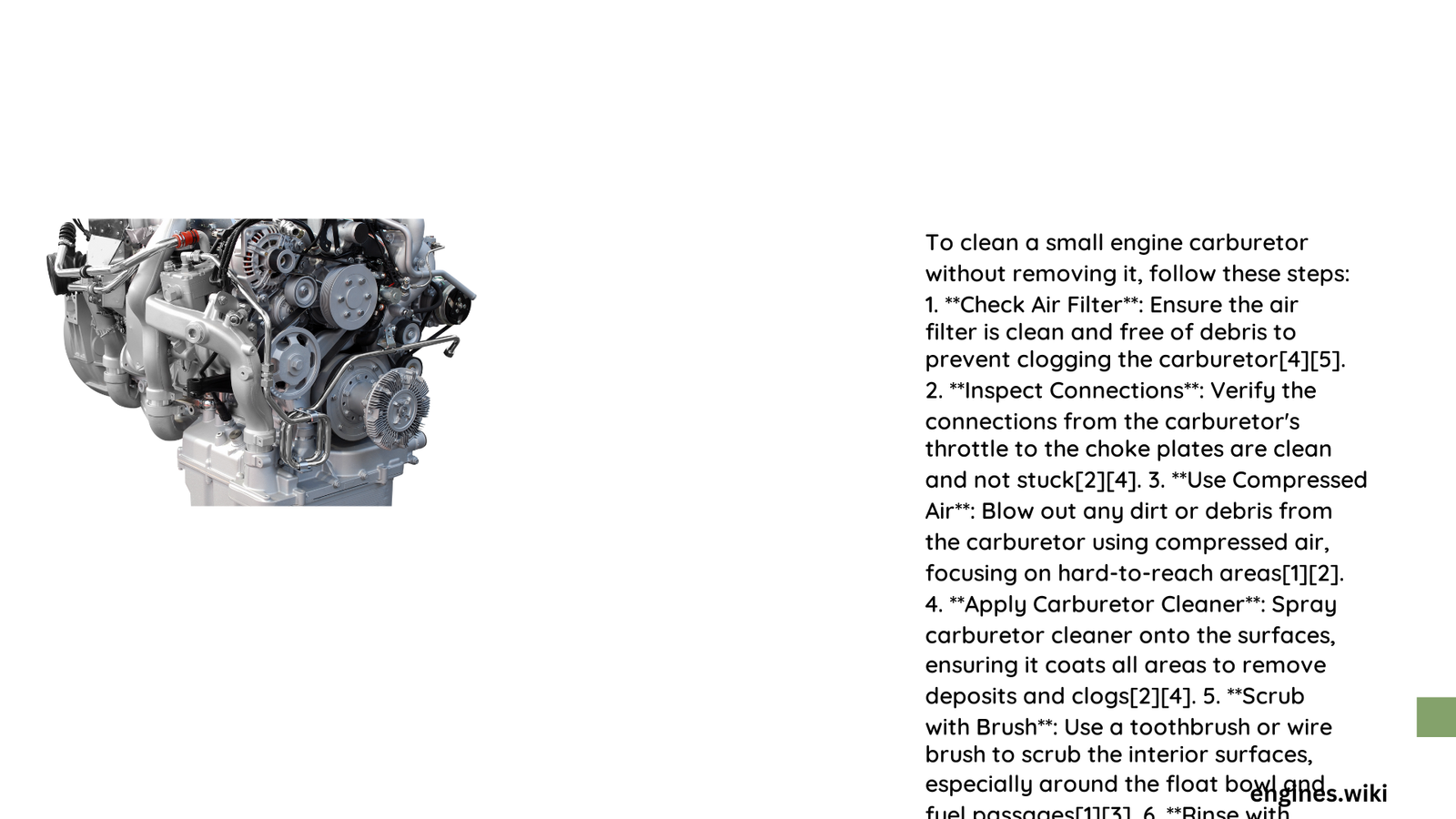Small engine carburetors often accumulate debris, varnish, and residue that can significantly impact performance, causing hard starts, rough idling, and reduced fuel efficiency. Professional mechanics and experienced DIY enthusiasts have developed specialized techniques to clean carburetors thoroughly without complete removal, saving time and preventing potential damage during disassembly. This comprehensive guide reveals expert methods to restore your small engine’s carburetor performance using targeted cleaning strategies.
Why Clean Small Engine Carb Without Removing?
What Causes Carburetor Performance Degradation?
Carburetor performance declines due to several critical factors:
- Fuel Residue Buildup: Stale gasoline leaves sticky varnish deposits
- Debris Accumulation: Dust, dirt, and microscopic particles block critical passages
- Oxidation: Metal components develop corrosive layers
- Moisture Contamination: Water introduces rust and chemical breakdown
What Tools Do Professionals Recommend?
| Tool | Effectiveness | Cost | Ease of Use |
|---|---|---|---|
| Carburetor Cleaner Spray | High | Low | Easy |
| Compressed Air Blower | Medium | Medium | Moderate |
| Chemical Cleaning Solution | High | Medium | Moderate |
Step-by-Step Cleaning Process

How to Prepare Your Small Engine?
- Safety Precautions
- Disconnect spark plug wire
- Work in well-ventilated area
-
Wear protective gloves and eyewear
-
Initial Inspection
- Check for visible debris
- Identify blocked jet openings
- Assess overall carburetor condition
What Cleaning Techniques Work Best?
Chemical Spray Method
Recommended Products:
– Berryman’s Chemtool B12
– Sea Foam Motor Treatment
– Gumout Carb + Choke Cleaner
Application Steps:
1. Remove air filter housing
2. Locate carburetor fill tube
3. Spray cleaner directly into passages
4. Allow 10-15 minutes penetration time
5. Use compressed air to blow out loosened debris
Compressed Air Technique
Required Equipment:
– Air compressor
– Precision nozzle attachment
– Safety glasses
– Clean workspace
Cleaning Process:
– Disconnect fuel lines
– Blow air through various carburetor openings
– Use moderate pressure
– Rotate engine to access different angles
Advanced Maintenance Tips
How to Prevent Future Carburetor Issues?
- Fuel Management
- Use fresh gasoline
- Add fuel stabilizer
-
Drain fuel for long-term storage
-
Regular Maintenance
- Clean air filter quarterly
- Inspect carburetor annually
- Use high-quality fuel additives
What Warning Signs Indicate Carburetor Problems?
- Difficult engine starting
- Inconsistent idle
- Reduced power output
- Excessive fuel consumption
- Black smoke from exhaust
Common Mistakes to Avoid
- Using excessive chemical cleaner
- Applying too much compressed air pressure
- Neglecting protective equipment
- Skipping initial visual inspection
- Using incorrect cleaning solutions
Troubleshooting Complex Issues
When simple cleaning methods fail, consider:
– Professional diagnostic service
– Ultrasonic cleaning
– Complete carburetor replacement
Pro Tip: Always consult your engine’s specific manual for model-specific guidance.
Final Recommendations
Consistent, gentle cleaning prevents major carburetor issues. Invest time in preventative maintenance to ensure long-lasting small engine performance.
Estimated Maintenance Time
- Basic Cleaning: 30-45 minutes
- Comprehensive Cleaning: 1-2 hours
Cost-Effectiveness
- DIY Cleaning: $10-$30
- Professional Service: $75-$200
Reference:
– Berryman Products Official Website
– Small Engine Maintenance Guide
– Professional Mechanic Forums
